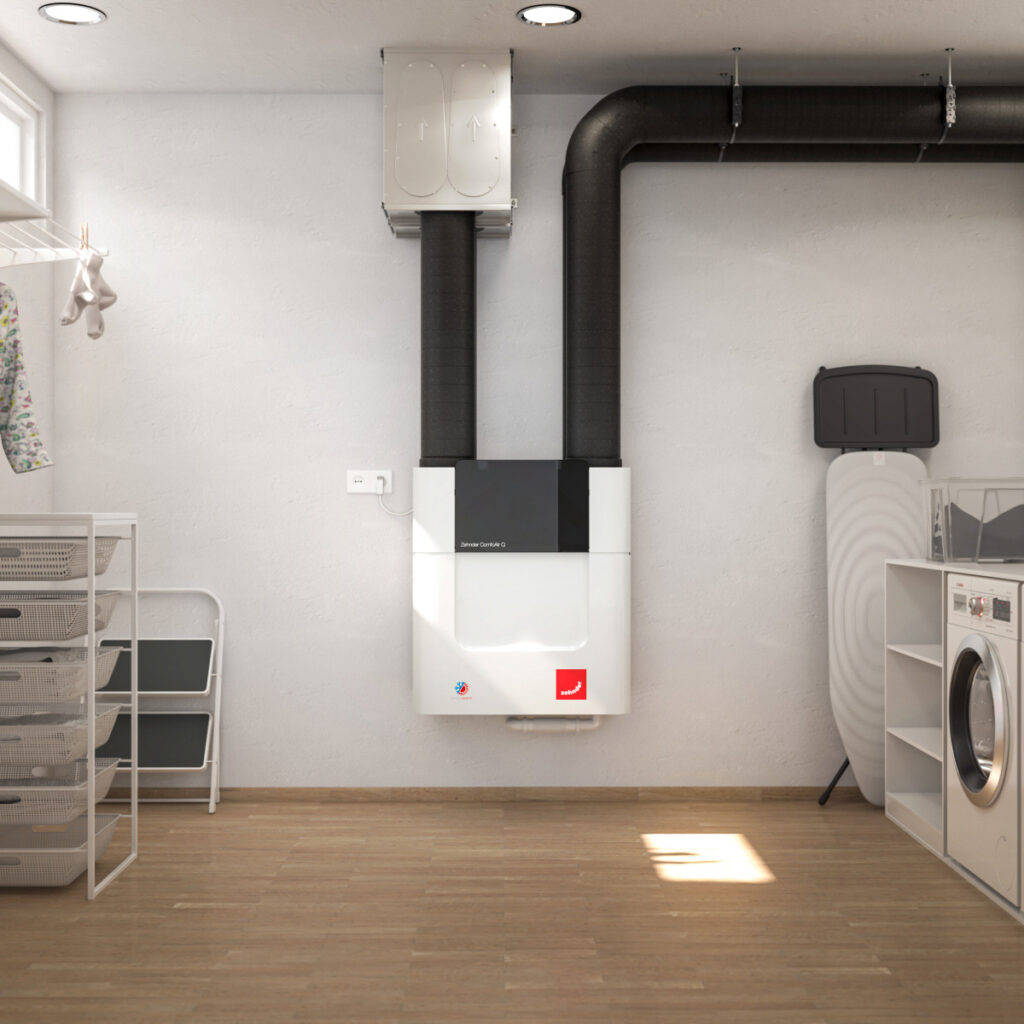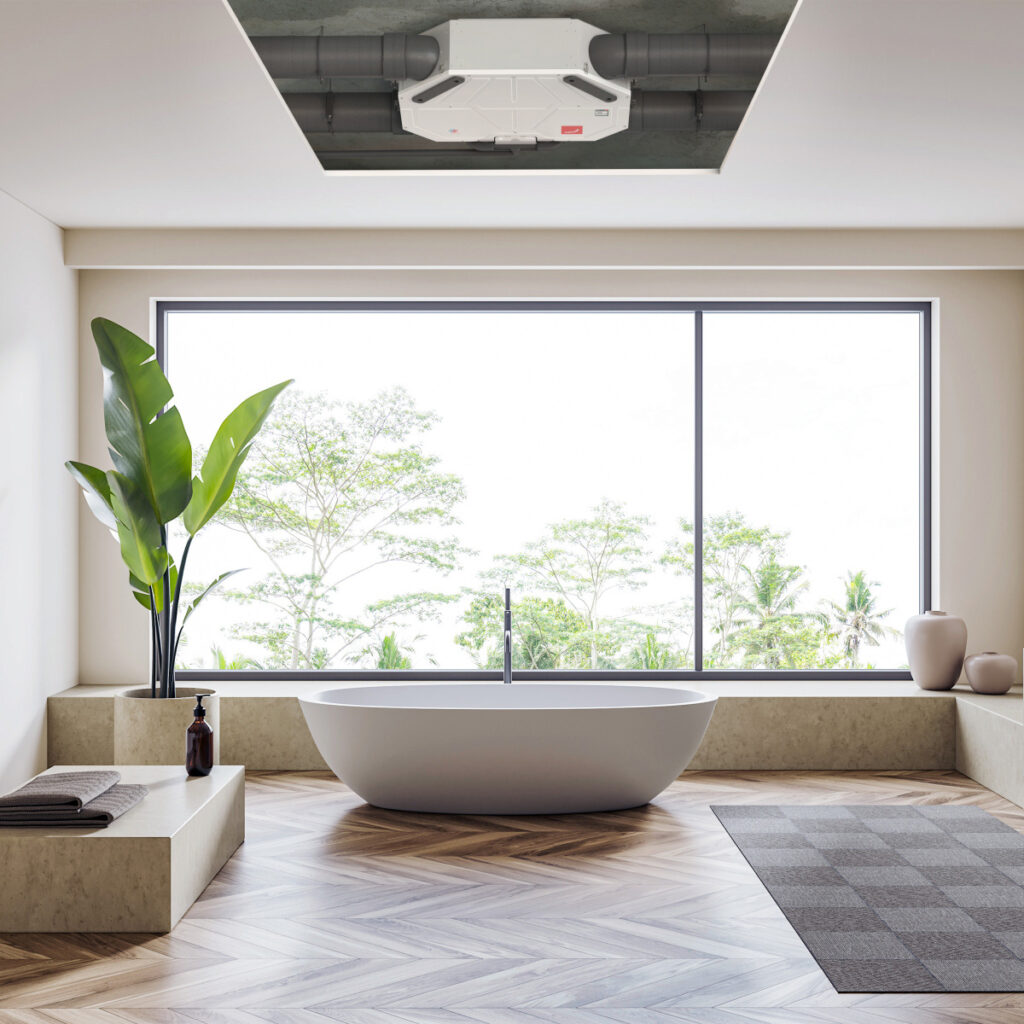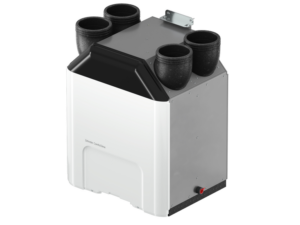
Mechanical Ventilation with Heat Recovery (MVHR) is a system designed to provide continuous ventilation to buildings while recovering heat from the outgoing air to pre-warm the incoming fresh air. This process not only improves indoor air quality but also enhances energy efficiency by reducing the heating (or cooling) load on the building.
There are many advantages of MVHR systems. From decreasing CO2 levels which can lead to headaches and drowsiness to filtering out harmful particulate matter, VOCs and humidity.
Not only does MVHR benefit your health but it also prevents costly damage to your home such as the buildup of damp and mould, which can destroy walls, ceilings and floors.
Benefits of MVHR
Energy Efficiency:
By recovering heat from the outgoing air, MVHR systems reduce the amount of energy needed to heat incoming air, leading to significant energy savings and lower heating bills.
Improved Indoor Air Quality:
MVHR systems continuously supply fresh, filtered air to the building, reducing indoor pollutants, allergens, and moisture levels, which can improve occupant health and comfort.
Consistent Ventilation:
Provides a constant supply of fresh air and consistent extraction of stale air, maintaining a healthy indoor environment without the need to open windows, which can compromise security and energy efficiency.
Heat Recovery:
In colder months, the heat recovery process pre-warms the incoming air, reducing the need for additional heating. In warmer months, some systems can also bypass heat recovery to provide cooler fresh air.
Reduced Condensation:
By effectively managing humidity levels, MVHR systems help to reduce the risk of condensation, mold growth, and dampness, protecting the building structure and interior finishes.


Types of MVHR
Centralised MVHR is achieved by the installation of a main MVHR air handling unit in a cupboard space or loft, which is connected via ducts to air vents throughout your home.
These vents are designed to be discreet and modern in design, there is a large range of vents available that are designed to fit flush to ceilings and walls and some are paintable.
Decentralised MVHR systems offer you fresh, filtered air, without the need for ducting. It consists of individual units which extract stale air, recover heat and supply fresh, filtered air into your home. These units can work independently or collectively, it’s your choice.
Components of an MVHR System
Heat Exchanger:
The core component where heat transfer occurs between the outgoing and incoming air streams.
Ductwork:
Network of ducts that distribute air throughout the building, including supply ducts for fresh air and exhaust ducts for stale air.
Fans:
Energy-efficient fans that move air through the system, ensuring adequate ventilation rates.
Filters:
Filters that clean the incoming air, removing dust, pollen, and other contaminants before it enters the building.
Controls:
Advanced controls and sensors that optimize system performance, adjusting ventilation rates based on occupancy and air quality needs.
How MVHR Works
- Air Extraction: Stale and moist air is extracted from wet rooms such as kitchens, bathrooms, and utility rooms. This air is typically warm, containing heat that would otherwise be lost.
- Heat Recovery: The extracted air passes through a heat exchanger within the MVHR unit. The heat exchanger transfers the heat from the outgoing stale air to the incoming fresh air without mixing the two air streams.
- Air Supply: Fresh, filtered air is drawn from the outside. This air passes through the heat exchanger, where it is warmed by the outgoing air, and is then supplied to living spaces such as bedrooms and living rooms.
- Exhaust: The cooled, stale air is exhausted to the outside, completing the cycle.
Why choose MVHR?
Sustainability:
MVHR systems contribute to sustainable building practices by enhancing energy efficiency and reducing the carbon footprint of heating and cooling.
Comfort:
They provide a balanced indoor climate with fresh air and consistent temperatures, enhancing overall comfort.
Health:
Improved indoor air quality supports better health outcomes for occupants, reducing the risk of respiratory issues and other health problems.
Applications of MVHR
Residential Buildings:
MVHR systems are commonly used in energy-efficient homes, such as passive houses, where maintaining air quality and energy efficiency is paramount.
Commercial Buildings:
Offices, schools, and other commercial buildings benefit from MVHR by ensuring a healthy working environment and reducing operational costs.
New Builds and Retrofits:
While MVHR is easier to install in new constructions, it can also be retrofitted into existing buildings to enhance ventilation and energy performance.

Using additional units such as Zehnder’s ComfoClime, ComfoFond-L and ComfoPost, it is possible to use an MVHR system as a solution to your heating and cooling needs. These units utilise advanced technologies such as heat pumps to enhance temperature regulation in all types of spaces, from compact apartments to commercial premises, helping to create a comfortable, energy-efficient environment, all year round.
From a small family-run mechanical workshop in Gränichen, Switzerland, Zehnder grew into a leading international provider of solutions for a healthy and comfortable indoor climate. The company roots are deeply intertwined with the entrepreneurial spirit of the Zehnder family that has been shaping the company for over 125 years. As chairman of the company Hans-Peter Zehnder presides over the board of directors since 2014. Together with the board members and the executive committee he ensures that Zehnder stays on target within the long-term company strategy. Meanwhile, the next generation is already waiting in the wings. Milva Inderbitzin-Zehnder, the daughter of Hans-Peter Zehnder represents the fifth generation of the family to join the board of directors. Yet, another example of the Zehnder family's determination to continue assuming responsibility for the group in the future.

